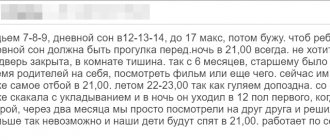A lack of breast milk or weak lactation leads to the fact that the baby simply does not get enough to eat. Do not rush to take drastic measures. Such as supplementary feeding, transition to mixed feeding and supplementary feeding. These measures are not necessary for the baby, since the baby receives the necessary elements from breast milk.
Only mother's milk provides 100% of the substances a newborn needs. In addition, such methods lead to an even greater deterioration in lactation; milk may soon disappear completely. And supplementing the baby with food leads to colic and other digestive disorders.
How to tell if your baby has enough milk
- The baby is crying a lot. There can be many reasons for crying, so this symptom alone should not be considered as an indicator of a specific problem (malnutrition, colic, illness or lack of attention). The cause of crying can only be identified through a combination of several signs;
- Weakness and decreased activity of the baby. Remember that a child is calm because of his character, and not because of a lack of milk;
- The newborn sleeps poorly or does not sleep at all;
- Insufficient number of bowel movements. In the first month after birth, stool occurs 8-12 times a day after almost every feeding. Then the frequency gradually decreases and reaches 1-2 times a day. The absence of stool for two or more days is a sign that the baby is constipated. Read more about newborn stool standards at https://vskormi.ru/problems-with-baby/kakim-dolzhen-byt-stul-u-novorozhdennogo/;
- The baby sucks his finger and the edges of the diaper, smacks his tongue or lips. These signs indicate that the baby is not getting enough breast milk and is looking for a breast further;
- The baby does not gain weight or loses it. In the first month, a newborn should gain on average 90-150 grams per week. During the second to fourth month - 140-200 grams per week. After the fifth month, the increase gradually decreases. By six months, the baby's weight should approximately double its value at birth. You can learn more about the norms for weight gain for infants up to one year old here;
- The intake rate does not play a big role in determining whether the baby has enough milk. This norm is different and depends on the baby’s age, individual development and needs. As a rule, in the first four days a newborn eats about 200 ml of breast milk per day, by a month the norm increases to approximately 600 ml.
Why doesn't the baby eat?
When a baby does not get enough breast milk, the main reason is a lack of breast milk and low lactation levels. In this case, you need to figure out why the milk disappears. Most often, low milk production is due to improper nutrition of the nursing mother.
Some foods change the taste of milk, so a newborn may refuse to breastfeed. And some products even lead to the disappearance of milk. Read what a nursing mother can eat in the “Nutrition after childbirth” section.
However, the baby may not eat enough even with normal milk production. This means that he is not getting enough milk. As a rule, this occurs due to incorrect organization of breastfeeding, uncomfortable feeding position and improper latching of the nipple.
The psychological state of the baby and mother is an important factor during breastfeeding. Depression, psychological unpreparedness to breastfeed or accept milk, painful sensations in the breast and cracked nipples lead to the fact that milk disappears or the child rejects and does not take the breast.
How much should an infant eat?
When a baby is breastfed naturally, there are no specific standards that determine the amount of milk consumed, the amount of time the baby should be at the breast, and how often the baby should be fed. To find out whether a baby has enough milk, you should carefully analyze its behavior and condition.
The regularity of wet diapers, good weight gain, the child’s ability to feed at intervals of two hours and restful sleep indicate that there is enough milk. Based on the approximate norm, meals should be taken on average 12 times a day. In this case, the break from feeding to feeding should be two to three hours, but slightly less is allowed.
You need to put the baby to the breast at the first request. Feeding occurs until satiety and the baby does not let go of the nipple. At the same time, it is worth making sure that the feeding period is active - the baby should suck the breast, and not sleepily chew it. This is, first of all, necessary for the mother who needs proper rest.
In the course of organizing breastfeeding, a separate nuance follows. The milk itself consumed by the baby can be divided into two types: “back” and “front”. The latter has a more watery base, with a higher content of milk sugar and dissolved nutrients (proteins, minerals, etc.). This species is used by the child as a drink. The first type is characterized by increased nutritional value and fat content.
Its color is yellowish, due to fat-soluble enzyme substances and the saturation of milk with fat. It is impossible to determine exactly at what point one type passes into the other, but it is extremely important that the baby receives these two types in full. To this end, you should feed your baby a little longer on one breast before moving on to the other.
You can find out what foods increase lactation in our article. Read about mushrooms during breastfeeding here.
Is it possible to have chocolate while breastfeeding, read the link
Solution
If the baby does not get enough breast milk, and lactation is at a good level, it is necessary to monitor the progress of feeding. Incorrect feeding posture and improper latching of the nipple lead to the baby not receiving the required portion of milk.
When feeding, the baby should grasp both the nipple and the area around it with a radius of 2-2.5 cm (areola). Make sure that the nose rests, but does not sink into the chest. In this case, both lips should be turned outward, and the child can freely adjust the nipple in the mouth. The baby should latch on to the breast on his own; do not force or push in the nipple. Force feeding leads to improper nipple latching. If your baby doesn't latch on, give him a thumb suck.
If the problem is lactation, it is necessary to increase stimulation of milk production. There are many methods that will help establish lactation without harming the baby. Among the most effective methods are:
- Drink more fluids. Warm, abundant drinking will ensure successful lactation, strengthen the immune system and help with viral diseases. The minimum volume of liquid per day is 2 liters, half of which should be drinking water. Otherwise, you can drink dried fruit compote and weak tea. Soups and broths are also sources of liquid;
- Adjust your diet. Remember that the menu must include the necessary vitamins and elements. Be sure to eat vegetables and fruits, meat and fish. But it is better to avoid foods that are too fatty and spicy during breastfeeding. Reduce your consumption of salty foods, sweets and starchy foods. By the way, there are foods and drinks that increase. You can find a list of these products at the link /;
- Get more rest and sleep, walk in the fresh air and do simple exercise. Yoga or swimming are activities that are not contraindicated for a nursing mother. At the same time, you will quickly regain your prenatal figure, recharge with energy and good mood;
- Breast massage. Circular movements in a clockwise direction stimulate lactation and, if necessary, will help eliminate lumps and strain the milk. In addition, massage is a prevention of lactostasis and mastitis. However, keep in mind that breastfeeding massage should be enjoyable and not painful;
- Feed not according to a schedule, but according to the baby’s demand. Frequent feeding will help enhance lactation. During the day you can feed every 1-2 hours, and at night - at least four times. ;
- Be sure to take care of your breast hygiene. Wash twice a day without using regular soap and towels, as they irritate the skin. For washing, use neutral liquid soap, and for wiping, use soft napkins. Keep an eye on your nipples, as cracks and abrasions on the nipples cause discomfort and dangerous diseases. Such as staphylococcus, mastitis and other infections;
- Drink decoctions of cumin, dill and fennel. However, use folk remedies with caution, as some components cause allergies in infants. Special teas for nursing mothers will also help.
Tips from the article “Problems with lactation” will help you improve milk production. When breastfeeding, it is important to maintain stress resistance and a comfortable emotional background. However, many mothers experience depression after childbirth. Lack of sleep, fatigue and other problems lead to strong feelings. In this case, do not rush to take sedatives, as some drugs negatively affect the composition of milk and the condition of the newborn.
Relaxing baths and aromatherapy, good sleep and walks in the fresh air will help with depression and stress. Valerian, motherwort and glycine tablets are considered safe during lactation. But doctors do not recommend using modern sedatives, such as Persen or Novopassit, for nursing mothers. In addition, alcohol tinctures are contraindicated when breastfeeding.
How to increase your milk supply while breastfeeding
In order for the child to have enough nutrition, at the beginning, it is necessary to determine and eliminate the cause of the lack of available milk. Mostly, there is not enough milk due to the mother’s violation of the organization of breastfeeding.
To correct a neglected situation, you must adhere to the rules below:
- Feed the baby as required. Natural feeding is a separate natural system. Milk should be produced for the baby in the amount he needs for proper nutrition. The appearance of milk is directly related to the baby's stimulation of the nipple. In order for the system not to malfunction and to function properly, the baby must be attached to the breast according to his desire;
- How can you tell if your baby is full of milk? It's simple - he will let go of the chest. For this reason, this process should not be interrupted; the little baby should eat exactly as much as he wishes;
- It is checked whether the baby is attached to the breast correctly. When feeding, the baby should open his mouth wide, grasping the nipple and areola along with it. The baby's saturation occurs without the process being accompanied by extraneous sounds; only sips can be heard;
- For feeding you need to determine comfortable positions. There should not be one and it is recommended to alternate them. Whatever position is used, one rule must apply - when positioning the baby, its back, neck and back of the head must be placed in one straight line. The nipple should be located near the mouth, the baby’s posture should prevent his head from turning and attempts to reach the breast. If this happens, then the position is incorrect;
- When your baby can't get enough to eat, you should try alternating breasts at each feeding. Thus, the baby will drink both fore milk (watery) and hind milk with a more nutritious content;
- When the baby is weak and spends a lot of time sleeping, you need to wake him up to feed him. You should not sleep for more than 3 hours during the day, and more than 5 hours at night. To increase appetite, you can wash your baby before feeding. A certain proportion of babies suck milk much better without clothes;
- There is no need to give pacifiers and bottles, or give them less often. The baby begins to suck them differently and when he is put to the breast, he does the same. At the same time, nothing works out for him and subsequently he has to switch to an artificial type of feeding;
- It is necessary to rest and sleep more while the baby is sleeping;
- It is necessary to accept any help provided by relatives regarding the care of the baby;
- You need to eat three to five times a day. Food should not only be tasty, but also healthy, with a high content of proteins and carbohydrates. Requires a lot of fluid;
- If a baby has health problems, he should be shown to a pediatrician and find out what the reason is.
When is supplementation needed?
Sometimes, if a child does not get enough breast milk, doctors recommend supplementary feeding. However, please note that this can only be done on the recommendation of a doctor! As a rule, supplementary feeding is prescribed when the mother is ill and has been taking medications for a long time that are incompatible with lactation. In addition, supplementary feeding is necessary if the baby does not gain or loses weight, as well as if the baby was born premature.
Supplemental feeding with the mixture should be 30-50% of the daily volume of food. If the dose is exceeded, mixed feeding will turn into artificial! And without breast milk, the baby will not receive the necessary elements and vitamins for full growth and development. In addition, to maintain breastfeeding, it is better not to use bottles and pacifiers. The baby quickly gets used to the nipple and subsequently refuses the breast. The rules of mixed feeding will tell you how to properly feed your baby and which formula to choose.
Common Misconceptions
There are a number of misconceptions about feeding. Inaccurate information regularly appears on the Internet on forums for young mothers. Many pieces of advice can only do harm.
Remember:
Weighing before and after feeding does not allow you to objectively assess whether the baby is full. The measurement error is too large.- Do not supplement with artificial formulas. During subsequent feedings, the baby will consume less mother's milk, and as a result, lactation will quickly decrease.
- You should not give your baby goat or cow's milk - his still immature digestive tract is not able to adequately absorb these products. The consequence can be serious problems with the stomach and intestines. For the same reason, it is not recommended to introduce complementary foods in the first six months of life.
- There is no need to supplement the baby with water; With milk, he normally receives quite a sufficient amount of fluid.
- The mother's consumption of large amounts of cow's milk does not affect lactation in any way.
Supplementary feeding is justified if the child was born prematurely, but even in this case it should account for no more than a third of the daily ration. Artificial formulas are introduced if the mother is shown pharmacological agents that are incompatible with breastfeeding.
Plisov Vladimir, medical observer
4, total, today
( 175 votes, average: 4.60 out of 5)
What to do if a child swallows a foreign object?
Complementary feeding at 4 months: how to do it correctly, what products can be used










